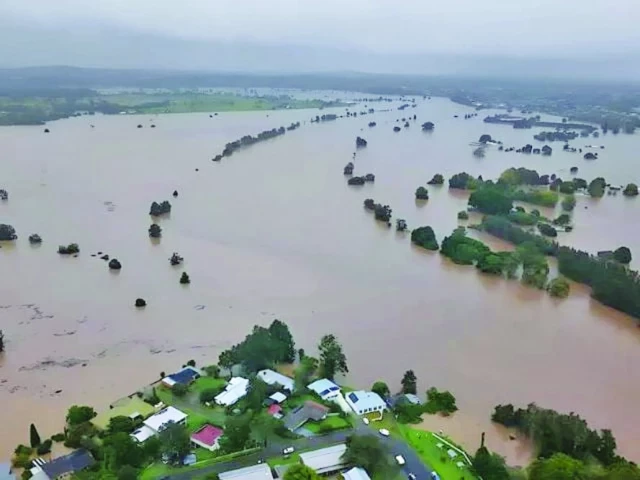LAHORE:
Pakistan is staring down the barrel of a meals safety emergency that might ripple by each layer of its financial system. The catastrophic monsoon floods of 2025 have submerged huge swathes of the nation, from Punjab’s wheat belt to Sindh’s rice-growing districts and components of Khyber-Pakhtunkhwa.
Over 2,000 villages have been inundated, displacing tens of millions, wrecking farmland, and wiping out crucial infrastructure simply because the summer season harvest reached its peak.
The destruction is staggering. Whole standing crops of wheat, cotton, rice, maize, and sugarcane have been destroyed. In Punjab alone, 80% of the nation’s wheat manufacturing is now in danger. Sindh’s rice fields and fodder provides are underwater, whereas Khyber-Pakhtunkhwa has misplaced tens of 1000’s of acres of maize and greens.
Livestock losses are mounting, with fodder destroyed and surviving cattle ravenous. Farmers are reporting private losses within the tens of millions, collectively wheat farmers alone have seen over Rs2.2 trillion worn out since final yr.
The ripple results are already seen in markets nationwide. In Lahore, Karachi, and Peshawar, staple meals costs have spiked 30% to 70%, with shortages of greens, milk, and meat now commonplace.
For city customers, the pinch is speedy and painful. For rural producers, the ache is existential, as fields, houses, livestock, and seed shops have been swept away.
Tens of 1000’s of households now reside in makeshift camps, with their livelihoods gone and no clear path to restoration. If left unsupported, tens of millions danger falling under the poverty line, a repeat of the 2022 floods which pushed 9 million Pakistanis into poverty, based on World Financial institution estimates.
The financial stakes are immense. Agriculture contributes 24% of Pakistan’s GDP and employs 40% of the workforce. The lack of this yr’s harvest won’t simply harm farmers; it would drive Pakistan to import huge portions of wheat, greens, and cotton, straining international alternate reserves and driving up the import invoice.
On the similar time, export earnings will collapse as rice and cotton surpluses disappear. This harmful mixture, increased imports and falling exports, threatens to widen the present account deficit and weaken the rupee.
Inflation, which had eased to 4.1% in July 2025 after painful reforms, is now set to surge once more. Authorities officers are bracing for meals inflation to return to double digits by October, with shortages of wheat and recent produce driving worth shocks. City and rural customers alike will really feel the squeeze, and political tensions are sure to rise as family budgets buckle below the strain.
The floods additionally pose a fiscal nightmare. Aid and reconstruction prices will run into lots of of billions of rupees, forcing the federal government to divert funds from different priorities or tackle new debt. Below an IMF programme, fiscal house is already restricted. Each rupee spent on aid is a rupee not spent on improvement, making a vicious cycle of stagnation and instability.
Making issues worse, coverage missteps have amplified the disaster. On the very second when Pakistan wanted stability and strategic reserves, the federal government moved to dismantle Passco, the one establishment able to safeguarding emergency wheat shares and stabilising costs. Passco’s warehouses, which as soon as held two million tons of grain, are being liquidated below IMF dictates.
Concurrently, the abolition of the Utility Shops Company has stripped tens of millions of poor households of entry to subsidised meals. This has left farmers on the mercy of profiteering cartels and customers defenseless in opposition to runaway inflation.
The World Financial institution’s newest report warns that local weather shocks are actually the one largest menace to Pakistan’s macroeconomic stability. Floods are not uncommon, one-off occasions, they’re recurring financial shocks that depress progress, widen deficits, and push tens of millions into poverty. The 2025 catastrophe is a textbook case – rising inflation, mounting imports, shrinking exports, and deepening social instability.
There are nonetheless steps that may stop a slide into famine. Emergency imports of wheat and greens, short-term worth controls, and focused money transfers to susceptible households can stabilise the state of affairs within the quick time period. Equally crucial is direct help for farmers – seeds, fertiliser, and credit score have to be offered instantly so the upcoming Rabi winter wheat crop will not be misplaced. With out this, Pakistan will face even deeper import dependency and meals insecurity in 2026.
Long run, Pakistan should lastly spend money on local weather resilience. Flood defences, drainage programs, climate-smart seeds, and dependable strategic reserves aren’t luxuries; they’re requirements for nationwide safety. Because the World Financial institution notes, financial planning should now deal with local weather volatility as a core structural problem, not a peripheral challenge.
The 2025 floods aren’t simply one other catastrophe. They’re a stark warning. If Pakistan doesn’t act decisively, this yr’s tragedy won’t solely wash away crops and houses, it would erode the very foundations of our financial system and go away the nation susceptible to the subsequent inevitable shock.
The author is a graduate of the College of British Columbia

